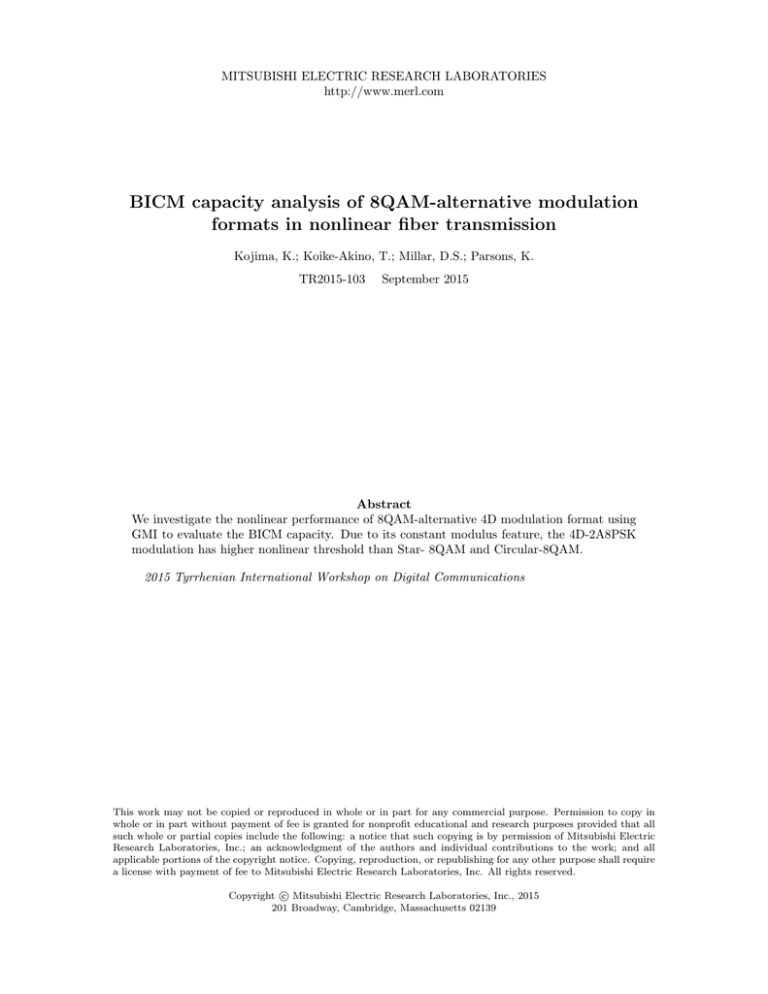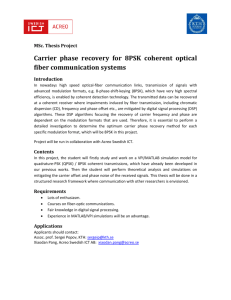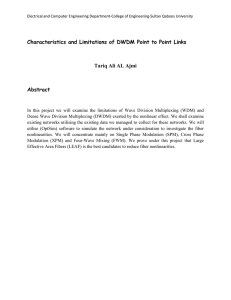
MITSUBISHI ELECTRIC RESEARCH LABORATORIES
http://www.merl.com
BICM capacity analysis of 8QAM-alternative modulation
formats in nonlinear fiber transmission
Kojima, K.; Koike-Akino, T.; Millar, D.S.; Parsons, K.
TR2015-103
September 2015
Abstract
We investigate the nonlinear performance of 8QAM-alternative 4D modulation format using
GMI to evaluate the BICM capacity. Due to its constant modulus feature, the 4D-2A8PSK
modulation has higher nonlinear threshold than Star- 8QAM and Circular-8QAM.
2015 Tyrrhenian International Workshop on Digital Communications
This work may not be copied or reproduced in whole or in part for any commercial purpose. Permission to copy in
whole or in part without payment of fee is granted for nonprofit educational and research purposes provided that all
such whole or partial copies include the following: a notice that such copying is by permission of Mitsubishi Electric
Research Laboratories, Inc.; an acknowledgment of the authors and individual contributions to the work; and all
applicable portions of the copyright notice. Copying, reproduction, or republishing for any other purpose shall require
a license with payment of fee to Mitsubishi Electric Research Laboratories, Inc. All rights reserved.
c Mitsubishi Electric Research Laboratories, Inc., 2015
Copyright 201 Broadway, Cambridge, Massachusetts 02139
BICM capacity analysis of 8QAM-alternative
modulation formats in nonlinear fiber transmission
Keisuke Kojima, Toshiaki Koike-Akino, David S. Millar, and Kieran Parsons
Mitsubishi Electric Research Laboratories
Cambridge, MA 02139-1955, USA
Telephone: +1 (617) 621–7500
Email: {kojima, koike, millar, parsons}@merl.com
the two polarizations is constant at the symbol time in T -space,
while the power of Star-8QAM and Circular-QAM can vary.
1
(1 0 1)
(1 0 0)
(0 0 0)
-0.5
-0.5
-0.5
0
0.5
M ODULATION F ORMATS
In this paper, we evaluate four different modulation formats. The most common formats include the Star-8QAM and
8PSK. Circular-8QAM [11] is an improvement over Star8QAM and 8PSK since the Euclidean distance is larger.
Figure 1 shows the constellation and labeling of Star-8QAM,
Circular-8QAM, and 8PSK. Constellation for the 4D-2A8PSK
format [9] is shown in Fig. 2. 4D-2A8PSK and DP-8PSK are
constant modulus formats, i.e., the total power summed over
(1 0 0)
(1 0 0)
-1
(0 1 0)
-1
(0 0 0)
0
-0.5
(1 1 0)
-1
1
-1
-0.5
0
0.5
-1
1
(0 1 0)
(1 1 0)
-1
I
-0.5
0
0.5
1
I
I
Fig. 1. Constellation and labeling [10] of (a) Star-8QAM, (b) Circular-8QAM,
and (c) 8PSK.
(a) (b) y-polarization
x-polarization
1
1
(0 1 1)
(0 1 0)
(1 1 1)
(0 0 0)
(1 0 0)
-0.5
0
I
(0 0 1)
1
5
-0.5
(1 1 1)
(0 0 0)
7
(1 0 0)
(1 0 1)
8
-1
-1
-1
3
(1 1 0)
0
6
(1 0 1)
2
(0 1 1)
(0 1 0)
0.5
1, 3,
5, 7
2, 4,
6, 8
0
-0.5
4
(0 0 1)
0.5
Q
II.
(1 0 1)
(0 0 0)
(1 1 1)
(1 0 1)
(1 1 0)
Current optical communication systems usually rely on
soft-decision (SD) forward error correction (FEC) coding
based on bit-interleaved coded modulation (BICM). Therefore,
using the BICM mutual information, also called generalized
mutual information (GMI), is a better metric for comparing
multiple modulation formats. Several 8QAM constellations
were compared using this metric [10] in the linear region.
In this work, we extend the use of GMI to the nonlinear
region for comparing two types of 8QAM, 8PSK, and 4D2A8PSK through nonlinear fiber transmission simulations. The
results show that the constant modulus property can effectively
increase the margin for fiber nonlinearity.
0.5
0
(0 1 1)
(0 0 1)
(1 1 1)
(0 0 1)
(0 0 1)
0
1
(0 1 0)
0.5
Q
Various modulation formats have been studied for coherent
optical communications [1]. 8-ary quadrature-amplitude modulation (8QAM) plays an important role in filling the gap
between quaternary phase-shift keying (QPSK) and 16QAM
in terms of bit rates and reach [2], [3]. It has also been
proposed that 8QAM-16QAM and QPSK-8QAM are used in
time-domain hybrid [4]. In order to achieve similar bit rates
with improved sensitivity, subset-optimized PSK codes [5],
quaternary code and sphere-cut lattice codes [6], [7], 4D honeycomb lattice codes [8], and 4-dimensional 2-ary amplitude 8ary phase-shift keying (4D-2A8PSK) [9] have been proposed.
4D-2A8PSK is especially attractive among these 3-b/s/Hz/pol
codes, since it has the properties of Gray coding and constant
modulus. The latter is important for reducing the penalty due to
fiber nonlinearities. Its gain over the conventional Star-8QAM
is more than 1 dB in uncoded cases.
(1 1 0)
0.5
(0 1 1)
(0 1 1)
(1 1 1)
1
Q
I NTRODUCTION
Q
I.
(c) 8PSK (b) Circular-­‐8QAM (a) Star-­‐8QAM Q
Abstract—We investigate the nonlinear performance of
8QAM-alternative 4D modulation format using GMI to evaluate
the BICM capacity. Due to its constant modulus feature, the 4D2A8PSK modulation has higher nonlinear threshold than Star8QAM and Circular-8QAM.
0.5
1
-1
-0.5
0
I
0.5
1
Fig. 2. Constellation and labeling of 4D-2A8PSK for (a) x-polarization,
and (b) y-polarization, where (0 1 0) etc. in (a) is the first half and in
(b) is the last half of the bits of the code word. Red numbers 1, 2, 3, ...
represent the constellation points corresponding in x- and y-polarizations. Red
and green circles in (a) and (b) indicate corresponding points in x- and ypolarizations [9]. For example, the point 2 has the code word of (0 0 0 0 0
1).
Figure 3(a) shows the dual polarization 8-ary phase-shift
keying (DP-8PSK) constellation in the Stokes space, where
each projected point represents 8 words of 6 bits which are
actually separated well in 4D space. The nearest words in the
4D space correspond to the nearest points in Fig. 3(a). In order
to increase the nearest points in the Stokes space, 4D-2A8PSK
uses the constellation configuration in Fig. 3(b), where the
8 constellation points are staggered and separated into two
groups. This increases the Euclidean distances.
(a)
(b)
DP-8PSK
Star-8QAM
4D-2A8PSK
Circular-8QAM
BER
10-1
10-2
10-3
10-4
Fig. 3. Stokes representation of (a) DP-8PSK and (b) 4D-2A8PSK [9].
The nearest neighbor in 4D space corresponds to neighboring points in the
Stokes space. It can be seen that the distance between points in 4D-2A8PSK
is increased from that of DP-8PSK.
5
6
7
8
9 10 11 12 13 14 15
SNR (dB)
Fig. 4. BER as a function of SNR calculated for the four modulation formats.
The 4D-2A8PSK format is expressed as
y(k, l) = b(k, l) eφl ,
π
φl = (l − 1),
4
l = 1, 2, . . . , 8,
a(k, l) = r1 , b(k, l) = r2 , (k + l = even),
a(k, l) = r2 , b(k, l) = r1 , (k + l = odd),
sin(θ + π/2)
cos(θ + π/2)
√
√
r1 =
, r2 =
.
2
2
3
2.55bits/s/Hz/pol
GMI (bits/s/Hz/pol)
x(k, l) = a(k, l) eφk ,
π
φk = (k − 1),
4
k = 1, 2, . . . , 8,
√
where = −1 and
The ratio of the two radii r2 /r1 determines the 4D effect.
If r2 /r1 = 1, the format is reduced to DP-8PSK. If r2 /r1 <
0.586, 4D-2A8PSK is not Gray coded. In this paper, we use
r2 /r1 = 0.65, which gives the best nonlinear performance.
5
6
7
8
9
10
11
12
SNR (dB)
GMI of the four modulation formats as a function of SNR.
AWGN C HANNEL P ERFORMANCE
We first evaluate the performance of those modulation
formats in an additive white Gaussian noise (AWGN) channel.
Bit error ratio (BER) was calculated as a function of signalto-noise ratio (SNR) by Monte Carlo simulations, as shown
in Fig. 4. Circular-8QAM and 4D-2A8PSK had nearly equal
BER performance over the whole SNR range. Even though
8PSK is worse than other formats at high SNR regimes, it
performs comparable to the other formats when SNR is low.
We then calculated GMI of the modulation formats for
AWGN channels. The procedure for calculating GMI is described in [12]. Here, we chose the normalized GMI of 0.85
(GMI = 2.55 b/s/Hz/pol) as the target [10] for the state-of-theart SD-FEC of a code rate around 0.8 [15]. Around the target
code rate, Circular-8QAM is slightly better than 4D-2A8PSK,
and much better than Star-8QAM and 8PSK.
IV.
Shannon Limit
Circular-8QAM
4D-2A8PSK
Star-8QAM
8PSK
2
1.5
Fig. 5.
III.
2.5
O PTICAL T RANSMISSION P ERFORMANCE
We simulated transmission performance over a 2,000 km
non-zero dispersion shifted fiber (NZDSF) link at a rate of
132 Gb/s per wavelength to investigate the effect of high
fiber nonlinearity. Modulated symbols are mapped to the four
dimensions (4D-2A8PSK), and two dimensions (DP-Circular8QAM, DP-Star-8QAM, and DP-8PSK). At the transmitter,
rectangular pulses were filtered by a root-raised-cosine (RRC)
filter with a roll-off factor of 0.1, which drives the I/Q
modulator. Five-wavelength channels with the same code were
simulated with 37.5 GHz spacing and no optical filtering.
The link comprises 25 spans of 80 km NZDSF with loss
compensated by Erbium-doped fiber amplifiers (EDFAs). In
order to quantify performance over a single link for multiple modulation formats, span loss budget was used as a
performance metric [13]. NZDSF parameters were, γ = 1.6
/W/km; D = 3.9 ps/nm/km; α = 0.2 dB/km. We used
coupled nonlinear Schrödinger equations to model the nonlinear fiber transmission. Other fiber effects such as dispersion
slope and polarization mode dispersion were not simulated.
At the end of each span, 90% of the chromatic dispersion
was compensated as a lumped linear dispersion compensator.
No dispersion pre-compensation was introduced. An ideal
homodyne coherent receiver was used, with a transfer function
described by the RRC filter of a roll-off factor of 0.1, followed
by sampling at twice the symbol rate. Following this, ideal
chromatic dispersion equalization and data-aided least-mean-
Span Loss Budget for GMI = 2.55 (dB)
Span Loss Budget for BER = 1e-2 (dB)
square equalization were employed. We first used a BER
threshold of 1 × 10−2 for a 20% hard decision (HD) FEC
with a code rate of 0.81 [14]. All the optical noise due to the
EDFA (4.0 dB noise figure) is loaded just before the receiver.
The plot of span loss budget vs. launch power for the four
modulation formats are given in Fig. 6.
22
4D-2A8PSK
Circular-8QAM
Star-8QAM
8PSK
21
20
19
18
21
20
19
18
17
4D-2A8PSK
Circular-8QAM
Star-8QAM
8PSK
16
15
14
13
-10
-8
-6
-4
-2
Launch power (dBm)
17
16
Fig. 7. Span loss budget of the 4 modulation formats with a target GMI of
2.55 b/s/Hz/pol.
15
14
13
-10
[2]
-8
-6
-4
-2
Launch power (dBm)
[3]
Fig. 6. Span loss budget of the four modulation formats with a target BER
of 10−2 .
[4]
We then evaluated the span loss budget with the target
GMI per bit of 0.85 (GMI = 2.55 b/s/Hz/pol). The optical
noise is added onto the transmitted signal including nonlinear
distortion, and the GMI is calculated at each optical noise level.
The required optical SNR (ROSNR) is calculated such that the
GMI reaches the target value. This ROSNR is used for calculating the span loss budget. The calculated span loss budget
for the four formats are shown in Fig. 7. In the low launch
power regime (−10 dBm) where linear propagation effects are
dominant, Circular-8QAM had a slightly higher margin than
4D-2A8PSK. For higher launch powers where nonlinearity is
dominant, the margin for 4D-2A8PSK becomes higher than
those for Circular-8QAM and Star-8QAM by 0.27 dB and 0.98
dB, respectively, due to its constant modulus property. It is
interesting to note that 8PSK gives 0.34 dB better margin than
the Star-8QAM, also benefiting from the constant modulus
property. In addition, Star-8QAM has larger Euclidean distance
than 8PSK, yielding better BER characteristics, while 8PSK
has Gray coding characteristics, giving relatively better GMI
performance.
[5]
[6]
[7]
[8]
[9]
[10]
[11]
[12]
V.
C ONCLUSION
We investigated several modulation formats which has the
same spectral efficiency as DP-8QAM in the presence of high
fiber nonlinearity through numerical simulations, using the
GMI as a metric. The recently proposed 4D-2A8PSK has 0.3
dB advantage over Circular-8QAM, and 1.0 dB over Star8QAM. We also found that 8PSK performs better than Star8QAM by 0.3 dB. These results indicate that constant modulus
property is important to reduce the effect of fiber nonlinearity.
R EFERENCES
[1]
22
E. Agrell and M. Karlsson, “Power-efficient modulation formats in
coherent transmission systems,” J. Lightw. Technol., vol. 27, no. 22,
pp. 5115–5126, 2009.
[13]
[14]
[15]
J. Zhang, H.-C. Chien, Z. Dong, Y. Xia, Y. Chen, and J. Xiao,
“Transmission of 480-Gb/s dual-carrier PM-8QAM over 2550km SMF28 using adaptive pre-equalization,” OFC, Th4F.6, 2014.
S. Zhang, F. Yaman, T. Wang, E. Mateo, T. Inoue, Y. Inada, and
T. Ogata, “Transoceanic transmission of dual-carrier 400G DP-8QAM
at 121.2km span length with EDFA-only,” OFC, W1A.3, 2014.
Q. Zhuge, X. Xu, M. Morsy-Osman, M. Chagnon, M. Qiu, and
D. V. Plant, “Time domain hybrid QAM based rate-adaptive optical
transmissions using high speed DACs,” OFC, OTh4E6, 2013.
M. Sjödin, E. Agrell, and M. Karlsson, “Subset-optimized polarizationmultiplexed PSK for fiber-optic communications,” IEEE Comm. Lett.,
vol. 17, no. 5, pp. 838–840, 2013.
D. S. Millar, T. Koike-Akino, S. Ö. Arik, K. Kojima, and K. Parsons,
“Comparison of quaternary block-coding and sphere-cutting for highdimensional modulation,” OFC, M3A.4, 2014.
T. Koike-Akino and V. Tarokh, “Sphere packing optimization and EXIT
chart analysis for multi-dimensional QAM signaling,” ICC, 2009.
H. Buelow, X. Lu, L. Schmalen, Z. Klekamp, and F. Buchali, “Experimental performance of 4D optimized constellation alternatives for
PM-8QAM and PM-16QAM,” OFC, M2A.6, 2014.
K. Kojima, D. S. Millar, T. Koike-Akino, and K. Parsons, “Constant
modulus 4D optimized constellation alternative for DP-8QAM,” ECOC,
P.3.25, 2014.
R. Rios-Mueller, J. Renaudier, L. Schmalen, and G. Gharlet, “Joint coding rate and modulation format optimization for 8QAM constellations
using BICM mutual information,” OFC, W3K.4, 2015.
R.-J. Essiambre, G. Kramer, P. J. Winzer, G. J. Foschini, and B. Goebel,
“Capacity limits of optical fiber networks,” J. Lightw. Technol., vol. 28,
no. 4, pp. 662–701, 2010.
A. Alvarado and E. Agrell, “Four-dimensional coded modulation with
bit-wise decoders for future optical communications,” J. Lightw. Technol., vol. 33, no. 10, pp. 1993–2003, 2010.
P. Poggiolini, G. Bosco, A. Carena, V. Curri, and F. Forghieri, “Performance evaluation of coherent WDM PS-QPSK (HEXA) accounting
for non-linear fiber propagation effects,” Opt. Exp., vol. 18, no. 11,
pp. 11360–11371, 2010.
B. P. Smith and F. R. Kschischang, “A pragmatic coded modulation scheme for high-spectral-efficiency fiber-optic communications,”
J. Lightw. Technol., vo. 30, no. 13, pp. 2047–2053, 2012.
K. Sugihara, Y. Miyata, T. Sugihara, K. Kubo, H. Yoshida, W. Matsumoto, and T. Mizuochi, “A spatially-coupled type LDPC code with
an NCG of 12 dB for optical transmission beyond 100 Gb/s,” OFC,
OM2B.4, 2013.





